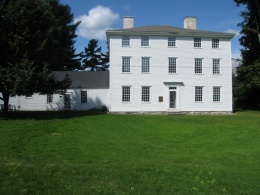More Podcast Pickings
Here are a couple more podcast reports from this weekend’s listening.
At Mainely History, Ian Saxine welcomed Sara Georgini of the Adams Papers for a discussion of John Adams’s work in the 1760s and early 1770s as an attorney. During those years Adams regularly traveled to the county courts in Maine and represented the powerful Kennebec Proprietors in their many lawsuits.
The Pownalborough Court House, built in the late 1760s and shown here, was one of the places Adams argued. It was also, Saxine states, an artifact of the Proprietors’ bid for influence and profits.
I’ve taken the liberty of transcribing something Saxine said in this conversation because it speaks to the interpretation of legal sources, with their particular rules and rituals:
Another interesting perspective came through in History Extra’s conversation with Ian Keable on his book The Century of Deception: The Birth of the Hoax in Eighteenth-Century England.
Keable is not just a historical researcher (and not just a chartered accountant), but a professional magician and mindreader. He thus brought a practiced eye to interpreting the witnesses who declared that, for example, Mary Toft couldn’t possibly have deceived anyone about giving birth to rabbits since they were watching her the whole time. Keable knows all too well how easily those people could be misdirected and fooled.
At Mainely History, Ian Saxine welcomed Sara Georgini of the Adams Papers for a discussion of John Adams’s work in the 1760s and early 1770s as an attorney. During those years Adams regularly traveled to the county courts in Maine and represented the powerful Kennebec Proprietors in their many lawsuits.
The Pownalborough Court House, built in the late 1760s and shown here, was one of the places Adams argued. It was also, Saxine states, an artifact of the Proprietors’ bid for influence and profits.
I’ve taken the liberty of transcribing something Saxine said in this conversation because it speaks to the interpretation of legal sources, with their particular rules and rituals:
One aspect of the writs that I thought was worth mentioning, especially since listeners who haven’t seen these sources would be surprised and confused, is that a lot of the way the writs work is that if you’re going to allege that something happened or accuse somebody of something you can’t bring up the evidence later on, and so these writs initially will just accuse the object of everything under the sun within this general umbrella.Georgini reports that Adams was conscientious about protecting his clients’ privileges and privacy. Therefore, as open as his family letters and diaries were, he rarely complained about the people he was working for or the weakness of their cases. More’s the pity.
So if you’re charging somebody with trespassing, you have to say, “And Sara Georgini did with force of arms did forcibly and willingly trespass, breaking down my fences…” Even if I know you did none of those things, but you still trespassed, just in case we find out that any of those things happened in the case, we need to go out and say it in the writ because otherwise we can’t bring it up. . . .
I know as a grad student I was thinking like, “Oh, my gosh! This is such a violent place! Everybody’s ‘through force of arms’ everythinging” because I was looking at a lot of trespass suits. And then I learned, no, no, this is just the language they used.
Another interesting perspective came through in History Extra’s conversation with Ian Keable on his book The Century of Deception: The Birth of the Hoax in Eighteenth-Century England.
Keable is not just a historical researcher (and not just a chartered accountant), but a professional magician and mindreader. He thus brought a practiced eye to interpreting the witnesses who declared that, for example, Mary Toft couldn’t possibly have deceived anyone about giving birth to rabbits since they were watching her the whole time. Keable knows all too well how easily those people could be misdirected and fooled.


No comments:
Post a Comment